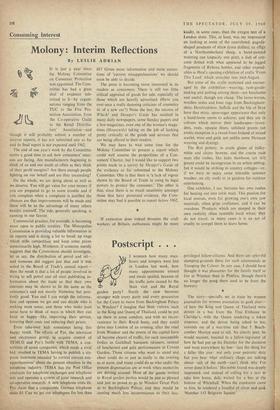Consuming Interest
Molony: Interim Reflections
By LESLIE ADRIAN The end of one year's work by the Committee seems a good time to ask how consumers' inter- ests are faring. Are manufacturers beginning to think of us and our needs as often as they think of their profit margins? Are there enough people fighting on our behalf and are they succeeding?
On the whole, we are doing about as well as we deserve. You will get value for your money if you are prepared to go to some trouble and if you complain when a complaint is justified the chances are that improvements will be made and these will be to the advantage of many others besides yourself. The tide, generally speaking, is running in our favour.
Commercial practice, for example, is becoming more open to public scrutiny. The Monopolies Commission is providing valuable information in its reports and is doing a lot to break up rings which stifle competition and keep some prices unnecessarily high. Moreover, if someone merely suggests that the Commission should investigate, let us say, the distribution of petrol and oil— and someone did suggest just that and it was noted in the Board of Trade's annual report— then the result is that a lot of people involved in trying to sell petrol and oil start publishing in- formation about the trade so that their own interests may be shown to be the same as the consumer's and not merely blameless but posi- tively good. You and I can weigh the informa- tion and opinion we get and can decide who is making most sense; and those who make least sense have to think of ways in which they can keep us happy—like improving their service, lowering their costs and reducing their prices.
Even take-over bids sometimes bring this happy result. The efforts of Pye, the television and electronics group, to acquire control of TEMCO and Pye's battle with TEMA, a con- sortium of seven companies, which made a rival bid, resulted in TEMA having to publish a six- point statement intended 'to correct current mis- apprehensions' about the present situation in the telephone industry. TEMA has the Post Office contracts for telephone exchanges and telephone sets and operates a• system of joint research and co-operative research. A new telephone costs £6. Pyc claim that a comparable German telephone costs £4. Can we get our telephones for less than £6? Given more information and more correc- tions of 'current misapprehensions' we should soon be able to decide.
The press is becoming more interested in its readers as consumers. There is still too little critical appraisal of goods for sale, especially of those which are heavily advertised. (Have you ever seen a really damning criticism of cosmetics or of a new car?) None the less, the success of Which? and Shopper's Guide has resulted in many daily newspapers, some Sunday papers and a few magazines, even one of the women's maga- zines (Housewife) taking on the job of looking pretty critically at the goods and services that are being offered to their readers.
We may have to wait some time for the Molony Committee to present a report which could well assume the proportions of a Con- sumers' Charter, but I would like to support two points made in a survey by Shopper's Guide of the evidence so far submitted to the Molony Committee. Obe is that there is 'a lack of vigour shown by the Board of Trade in using its legal powers to protect the consumer.' The other is that, since there is so much unanimity amongst those that have presented evidence, the Com- mittee may find it possible to report before 1962.
If extinction does indeed threaten the craft workers of Britain, euthanasia might be more kindly, in some cases, than the oxygen tent of a London store. This, at least, was my impression on looking at some of the convoluted, pagod4- shaped pendants of straw (corn dollies), an effigy of a Northumberland sheep, a hand-painted watering can (capacity one pint), a slab of con- crete dotted with what appeared to be jagged fragments of Rybena bottles, and other expend- ables ai Heal's opening exhibition of crafts 'From This Land' which stretches into mid-August.
But some of the crafts sustained and encour- aged by the exhibition—weaving, rush-goods- making and potting among them—are handsome and useful; though not cheap. The loose-woven, woollen stoles and knee rugs from Buckingham- shire, Herefordshire, Suffolk and the Isle of Skye have that misty, spun-sugar appearance that only a hand-loom seems to achieve; and they are in colours which mirror their landscapes—laven- ders, rusts, opaque blues, subdued greens (an exotic exception is a tweed from Ireland of mixed scarlet, wine and gold, not unlike some Mexican weaving and dyeing).
The Rye pottery, in crude glazes of milky- white and clayey browns, and the coarse rush mats (the rushes, like baby bamboos, are still green) could be incongruous in an urban setting; but it would be striking in country cottages—or, if we were to enjoy some tolerable summer weather, on city roofs or in gardens for outdoor entertaining.
One exhibitor, I see, harvests her own rushes for beating out into table mats. This passion.for local sources, even for growing one's own raw materials, often grips craftsmen; and it can be overdone. Products which are steeped in their own rusticity often resemble local wines; they do not travel; in many cases it is an act of cruelty to compel them to leave home.


































 Previous page
Previous page